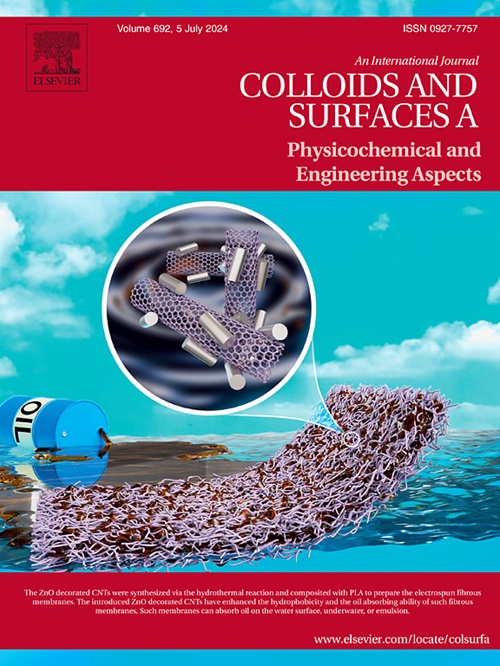Filtration of low-rank coal from the viewpoints of moisture migration and water occurrence state
IF 4.9
2区 化学
Q2 CHEMISTRY, PHYSICAL
Colloids and Surfaces A: Physicochemical and Engineering Aspects
Pub Date : 2025-04-17
DOI:10.1016/j.colsurfa.2025.136972
引用次数: 0
Abstract
Currently, research on low rank coal (LRC) filtration has focused on the variation of particle properties and cake structure, but few reports have focused on the moisture migration and water occurrence state. Herein, combining surface property tests, low-field nuclear magnetic resonance (LF NMR) technique, and Young-Laplace equation, the effects of cetyltrimethylammonium bromide (CTAB) and cationic polyacrylamide (CPAM) on LRC filtration were investigated from the viewpoints of moisture migration and water occurrence state. The results showed that the optimal dosages of CTAB and CPAM were 0.8 kg/t and 30 g/t, respectively. CTAB reduced the surface tension of the filtrate to 30.75 mN/m, while it increased the hydrophobic functional groups on the coal surface and the free water content in the filter cake 5.39 % and 7.17 %, respectively. Thus, CTAB increased the hydrophobicity of the pore walls and the flowability of the filtrate, and reduced the moisture binding of the pores. This promoted the moisture migration and caused part of the non-flowable capillary water in the filter cake to be transformed into flowable free water. However, CPAM reduced the absolute value of Zeta potential by 20.20 mV, decreasing the electrostatic repulsion between coal particles. Meanwhile, CPAM increased the floc size to 20–60 μm, which promoted floc formation and improved the pore structure, increasing the filter cake porosity by 5.19 %. This reduced the filtration resistance of the LRC and promoted the transformation of capillary water to free water, reducing the capillary water content by 12.27 %. This work provides a new perspective to reveal the filtration mechanism of LRC.
从水分运移和水赋存状态看低阶煤的过滤
目前,有关低阶煤(LRC)过滤的研究主要集中在颗粒性质和滤饼结构的变化上,但很少有报道关注水分迁移和水分发生状态。本文结合表面性质测试、低场核磁共振(LF NMR)技术和 Young-Laplace 方程,从水分迁移和水分发生状态的角度研究了十六烷基三甲基溴化铵(CTAB)和阳离子聚丙烯酰胺(CPAM)对低阶煤过滤的影响。结果表明,CTAB 和 CPAM 的最佳用量分别为 0.8 kg/t 和 30 g/t。CTAB 使滤液的表面张力降至 30.75 mN/m,同时增加了煤表面的疏水官能团,滤饼中的自由水含量分别增加了 5.39 % 和 7.17 %。因此,CTAB 增加了孔壁的疏水性和滤液的流动性,并降低了孔隙的水分结合力。这促进了水分的迁移,并使滤饼中部分不可流动的毛细管水转化为可流动的自由水。然而,CPAM 使 Zeta 电位的绝对值降低了 20.20 mV,降低了煤颗粒之间的静电排斥力。同时,CPAM 使絮凝物粒度增加到 20-60 μm,促进了絮凝物的形成,改善了孔隙结构,使滤饼孔隙率增加了 5.19 %。这降低了 LRC 的过滤阻力,促进了毛细管水向自由水的转化,使毛细管水含量降低了 12.27 %。这项研究为揭示 LRC 的过滤机理提供了一个新的视角。
本文章由计算机程序翻译,如有差异,请以英文原文为准。
求助全文
约1分钟内获得全文
求助全文
来源期刊
CiteScore
8.70
自引率
9.60%
发文量
2421
审稿时长
56 days
期刊介绍:
Colloids and Surfaces A: Physicochemical and Engineering Aspects is an international journal devoted to the science underlying applications of colloids and interfacial phenomena.
The journal aims at publishing high quality research papers featuring new materials or new insights into the role of colloid and interface science in (for example) food, energy, minerals processing, pharmaceuticals or the environment.

 求助内容:
求助内容: 应助结果提醒方式:
应助结果提醒方式:


